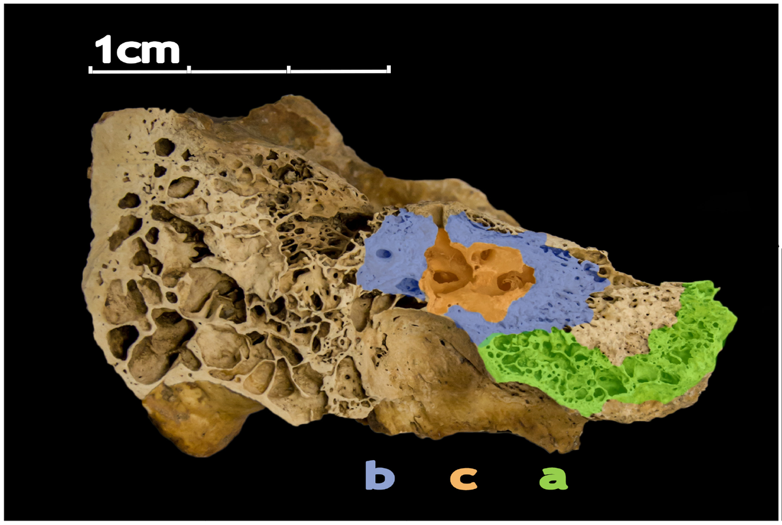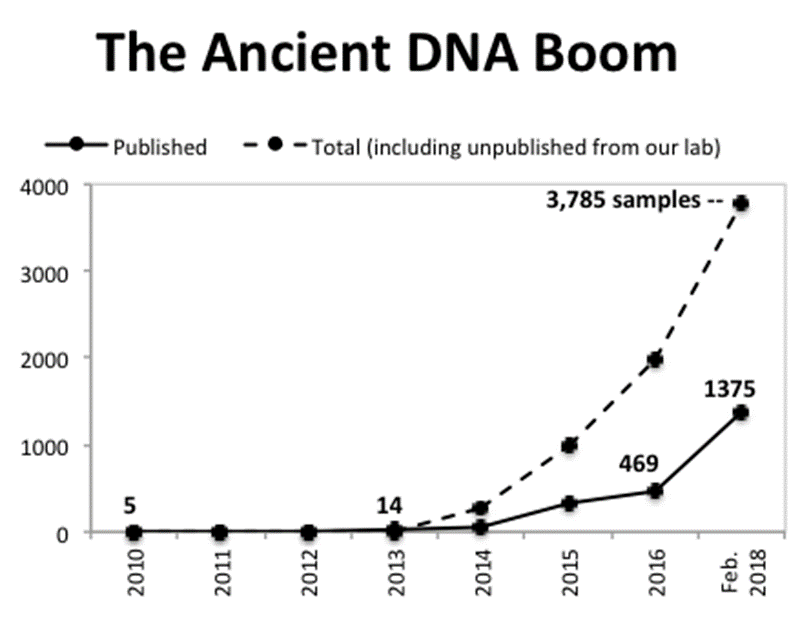 The human petrous bone in the skull protects the inner ear structures. Though it is one of the hardest, densest bones in the body, some portions (such as the area in orange, protecting the cochlea) are denser than others. Possibly because the petrous bone is so dense, DNA within the petrous bone is better preserved than in other bones. In some cases, scientists have extracted more than 100 times more DNA from the petrous bone than other bones, including teeth. Credit: Pinhasi et al., 2015, PLOS ONE.
The human petrous bone in the skull protects the inner ear structures. Though it is one of the hardest, densest bones in the body, some portions (such as the area in orange, protecting the cochlea) are denser than others. Possibly because the petrous bone is so dense, DNA within the petrous bone is better preserved than in other bones. In some cases, scientists have extracted more than 100 times more DNA from the petrous bone than other bones, including teeth. Credit: Pinhasi et al., 2015, PLOS ONE.For the past few decades, new evidence about ancient humans—in the form of skeletal remains, tools, and other artifacts—has trickled in, inching us closer to an understanding of how our species evolved and spread out across the planet. In just the past few years, however, knowledge of our deep past expanded significantly thanks to a series of technological breakthroughs in sequencing of ancient human genomes. This technology can be used to find genetic links among populations of human ancestors dating back hundreds of thousands of years.
In addition to advances in genomic technology, another factor is driving the explosion of new discoveries—an inch-long section of the human skull. Found near our ears, this pyramid-shaped portion of the temporal bone is nicknamed the petrous bone. The bone is very hard, possibly because it needs to protect fragile structures such as the cochlea, which translates sound into brain signals, and the semicircular canals, which help us maintain our balance. Perhaps because the petrous bone is so dense, it also is the bone in the body that best preserves DNA after a person dies. As a result, archaeologists are scrambling to study samples taken from this pyramid-shaped structure to unlock the mysteries of our species’ formative years.
Here’s a sampling of headlines declaring new findings about ancient peoples from around the globe that were based on genetic information obtained from the petrous bone (NIGMS-funded research indicated in black):
“How the introduction of farming changed the human genome” November 2015
“Fourth strand’ of European ancestry originated with hunter-gatherers isolated by Ice Age” November 2015
“Scientists sequence first ancient Irish human genomes” December 2015
“Genetic studies provide insight into ancient Britain’s diversity” January 2016
“The world’s first farmers were surprisingly diverse” June 2016
“Study reveals Asian ancestry of Pacific islanders” October 2016
“Ancient DNA solves mystery of the Canaanites, reveals the biblical people’s fate” July 2017
“Ancient DNA data fills in thousands of years of human prehistory in Africa” September 2017
“European Hunter-Gatherers Interbred With Farmers From the Near East” November 2017
“Surprise as DNA reveals new group of Native Americans: the ancient Beringians” January 2018
“Ancient DNA reveals genetic replacement despite language continuity in the South Pacific” February 2018
“Stone Age Moroccan Genomes Reveal Sub-Saharan African, Near Eastern Ancestry” March 2018
“Some early modern populations in Britain may have had dark skin” March 2018
To learn more about the petrous bone and its use in archaeology, as well as other advances in the field, I spoke with NIGMS grantee, a genetic archaeologist from Harvard Medical School and the Howard Hughes Medical Institute, and one of the world’s leading experts in ancient human DNA.
 Credit: Howard Hughes Medical Institute.
Credit: Howard Hughes Medical Institute.Chris Palmer:
How would you characterize the current state of research about ancient humans?
David Reich:
We’re going through a gold-rush phase in ancient DNA. It’s a technology-driven boom like those in the past, such as the development of the microscope and telescope in the 17th century, and radiocarbon dating in the 1950s.
The first ancient human genomes were published in 2010. Just a couple of months ago, the 1,000th was published. The number has been multiplying by about 10 every two years and that trend seems to be continuing. What this means is that it’s possible to ask and answer questions about how our ancestors all around the world are related to each other. Some of these questions were just not answerable even a few years ago.
 The first studies of ancient DNA were published in 2010. Since then, the number of ancient DNA samples that have been sequenced has grown exponentially. Credit: David Reich.
The first studies of ancient DNA were published in 2010. Since then, the number of ancient DNA samples that have been sequenced has grown exponentially. Credit: David Reich.Chris Palmer:
Which technologies are fueling this “technology-driven boom”?
David Reich:
The first technology is next-generation sequencing, which became available at the end of the 2000’s and made sequencing literally 10- to 100- thousand times cheaper.
Another innovation was an extraordinary increase in the efficiency of methods for extracting DNA from biological samples and the ability to turn that DNA into a sequenceable form. Most of these improvements were developed by Matthias Meyer and Svante Pääbo at the Max Planck Institute for Evolutionary Anthropology in Leipzig, Germany.
Yet another important innovation has been improvements in methods for separating out human DNA from microbial DNA, which tends to dominate the DNA extracted from most ancient biological samples.
Chris Palmer:
What is so special about the petrous bone, and what role has it played in advancing research in this field?
David Reich:
Bone powder taken from the petrous bone yields on average up to 100 times more DNA than powder from other, softer bones. Also, because it’s so dense, when the rest of a skeleton has crumbled into dust, the petrous bone often still remains. So, it’s been a real game changer for the field of ancient DNA.
Using the petrous bone as the source for ancient DNA has made it possible, for the first time, to begin to regularly extract DNA from older biological material, and from biological material that does not preserve very well, such as samples found in hot tropical environments.
Chris Palmer:
Can you pinpoint when scientists realized the value of the petrous bone?
David Reich:
In 2014 to 2015, a group in Ireland led by Ron Pinhasi published a paper that clearly documents how much better this type of bone was than other types of bone as a source for ancient DNA.
Chris Palmer:
What role has petrous bone had in advancing the work of your own research team?
David Reich:
Our first big finding based on petrous bone work was a paper in late 2015 where we reported the first ancient DNA from that population of farmers in Anatolia (present-day Turkey) who went on to populate Europe.
Then, in 2016 we published a paper that reported DNA from four individuals from islands in remote Oceania. We were able to show that those people, who lived between about 2,500 and 3,000 years ago, contributed very little to many of the people who live in those places today, suggesting that there must have been at least one later wave of migration into the region. That was really a big surprise.
A third finding was published a few months ago. We obtained DNA from an approximately 3,000-year-old herder from Tanzania and a little girl. The girl turns out to be from a keystone population that left East Africa and moved in all directions around that time.
[Each of these papers was done in collaboration with the Pinhasi group.]
Chris Palmer:
In response to repeated requests, you recently published a book [Who We Are and How We Got Here] that aims to make ancient DNA research accessible to anyone. Tell me about the book.
David Reich:
It’s a manifesto of the ancient DNA revolution and what its significance is, what it does and doesn’t show, and how it can be used and integrated with our current understanding of ancient humans.
While ancient DNA has already changed our views of the past, it hasn’t yet taught us much about human biology, such as how adaptations and traits spread through populations. We just haven’t yet had enough high-quality data. But the recent innovations, including the use of the petrous bone, are bringing us closer to being able to learn about the biology of ancient humans.
One of the big new findings that has emerged from the ancient DNA revolution—and that I emphasize in my book—is that human populations today are, almost without exception, highly mixed. Populations today almost never descend directly from the populations that existed in the same place even 10,000 years ago. I think that’s a very profound insight, and it should change the way we see our world.
David Reich’s research is funded in part by NIGMS under grant 5R01GM100233.
To learn more about what ancient DNA is telling us about our origins, read NIGMS program director Dan Janes’ Biomedical Beat story “Field Focus: High-Quality Genome Sequences Inform the Study of Human Evolution.”


So much adventure that National Geo could be surprising!